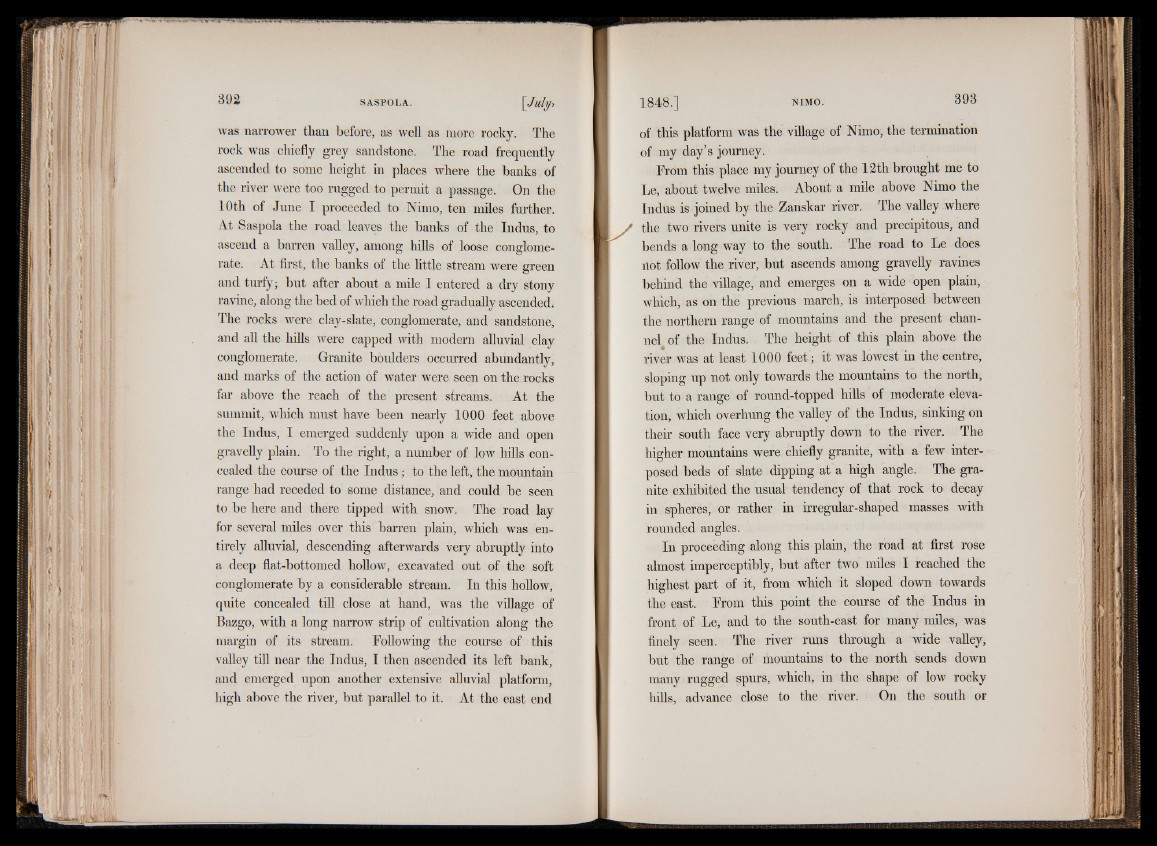
was narrower than before, as well as more rocky. The
rock was chiefly grey sandstone. The road frequently
ascended to some height in places where the banks of
the river were too rugged to permit a passage. On the
10th of June I proceeded to Nimo, ten miles further.
At Saspola the road leaves the banks of the Indus, to
ascend a barren valley, among hills of loose conglomerate.
At first, the banks of the little stream were green
and turfy; but after about a mile I entered a dry stony
ravine, along the bed of which the road gradually ascended.
The rocks were clay-slate, conglomerate, and sandstone,
and all the hills were capped with modern alluvial clay
conglomerate. Granite boulders occurred abundantly,
and marks of the action of water were seen on the rocks
far above the reach of the present streams. At the
summit, which must have been nearly 1000 feet above
the Indus, I emerged suddenly upon a wide and open
gravelly plain. To the right, a number of low hills concealed
the course of the Indus; to the left, the mountain
range had receded to some distance, and could be seen
to be here and there tipped with snow. The road lay
for several miles over this barren plain, which was entirely
alluvial, descending afterwards very abruptly into
a deep flat-bottomed hollow, excavated out of the soft
conglomerate by a considerable stream. In this hollow,
quite concealed till close at hand, was the village of
Bazgo, with a long narrow strip of cultivation along the
margin of its stream, hollowing the course of this
valley till near the Indus, I then ascended its left bank,
and emerged upon another extensive alluvial platform,
high above the river, but parallel to it. At the east end
of this platform was the village of Nimo, the termination
of my day’s journey.
Erom this place my journey of the 12th brought me to
Le, about twelve miles. About a mile above Nimo the
Indus is joined by the Zanskar river. The valley where
the two rivers unite is very rocky and precipitous, and
bends a long way to the south. The road to Le does
riot follow the river, but ascends among gravelly ravines
behind the village, and emerges on a wide open plain,
which, as on the previous march, is interposed between
the northern range of mountains and the present channel
of the Indus. The height of this plain above the
river was at least 1000 feet'; it was lowest in the centre,
sloping up not only towards the mountains to the north,
but to a range of round-topped hills of moderate elevation,
which overhung the valley of the Indus, sinking on
their south face very abruptly down to the river. The
higher mountains were chiefly granite, with a few interposed
beds of slate dipping at a high angle. The granite
exhibited the usual tendency of that rock to decay
in spheres, or rather in irregular-shaped masses with
rounded angles.
In proceeding along this plain, the road at first rose
almost imperceptibly, but after two miles I reached the
highest part of it, from which it sloped down towards
the east. Erom this point the course of the Indus in
front of Le, and to the south-east for many miles, was
finely seen. The river runs through a wide valley,
but the range of mountains to the north sends down
many rugged spurs, which, in the shape of low rocky
hills, advance close to the river. On the south or